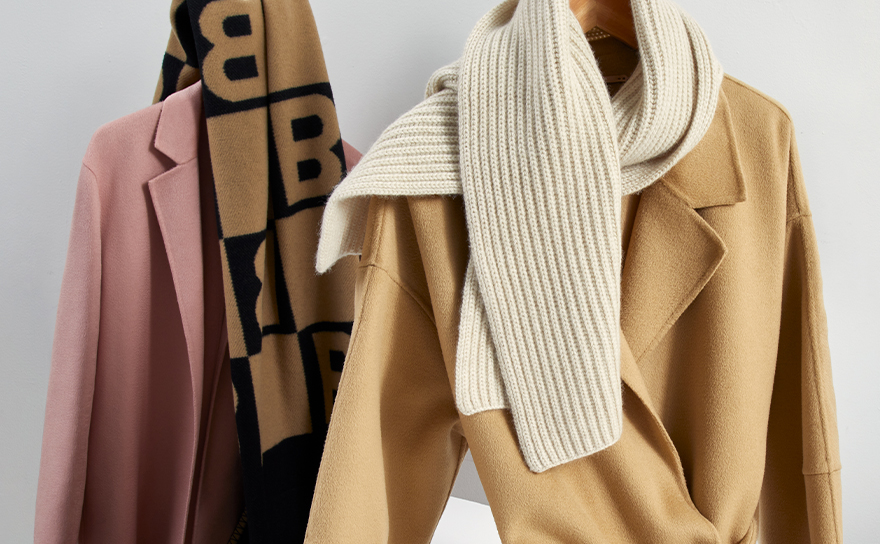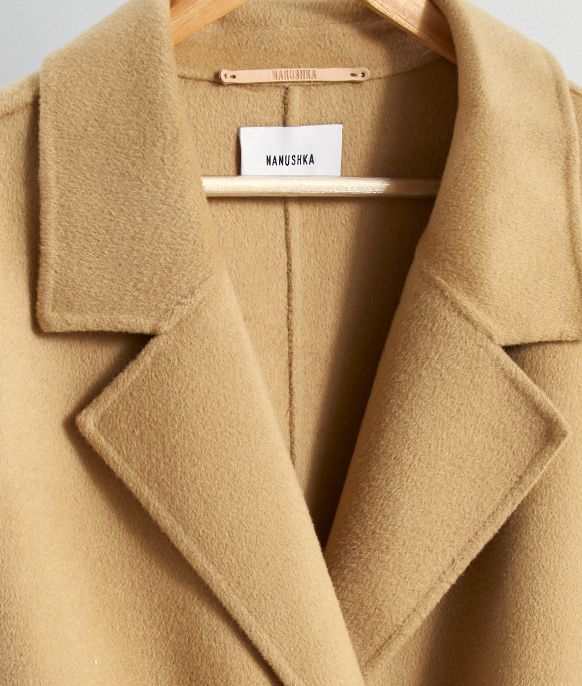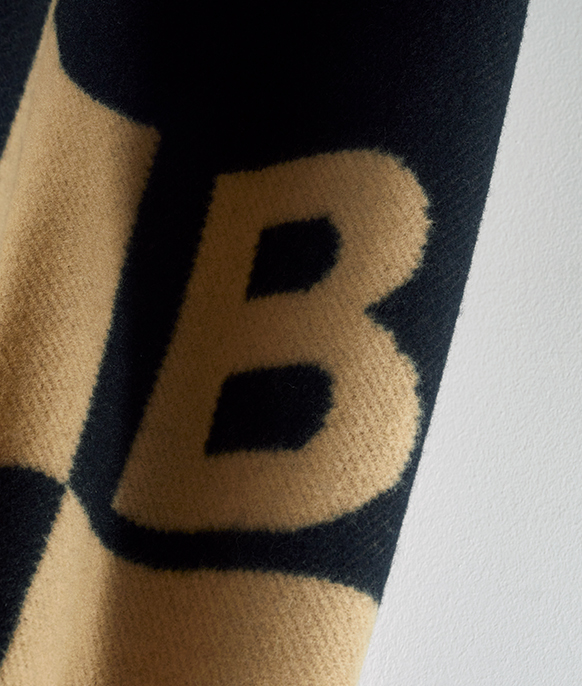

How To Wash & Store Cashmere & Wool
Every year, there’s that magical day that signals the beginning of fall. It may happen at different times in different places, but something in the air changes — a smell, a certain crispness — and you immediately know it’s time to unearth your sweaters. Or, maybe you’ve been hunkered down in your sweaters since March of this year; no one could blame you. Either way, it’s safe to say that the cozy pieces we turn to for warmth and comfort could often use some TLC at the turn of the season. It’s the least we can do to keep them fresh and extend their lives.
And extending the life of luxe fabrics like cashmere is key, especially now. Cashmere and wool are great sustainable choices since they’re natural and biodegradable (unlike synthetics including polyester and acrylic), but their production isn’t always light on the planet. A rise in global demand for cashmere has led to overgrazing, which, especially when combined with climate change, prevents regrowth and damages the land. Likewise, industrial scale wool production can result in land clearing. Forward-thinking designers like Stella McCartney are innovating more sustainable options, like the brand’s re-engineered cashmere, but one of the best ways to reduce impact is to extend the life of well-made pieces that already exist. Caring for your cozy cashmere and woolens means you can wear them for longer or sell them when you’re ready for something new-to-you. This keeps items in the circular economy, from closet to closet, instead of from closet to landfill. For example, by consigning just one wool sweater or buying it resale, you can save 101 liters of water and 4.13 kilograms of carbon.
Caring for something delicate like cashmere or shrinkable like wool can be intimidating, but it’s definitely doable — especially with a guide from a pro. Which is just what we got when we asked TRR Associate Fashion Valuation Manager Chris Chavez for his go-to tips, which emphasize sustainable cleaning methods to boot. Read on, and your sweaters, scarves and coats will be soft and sparkling clean in no time.
How To Wash Cashmere

You’ve splashed out on a luxurious cashmere sweater, but you don’t need to use excess water to keep it looking great. Much the way denim collectors treat their prized jeans, you don’t have to wash your cashmere after every single wear. “Limiting water consumption is my favorite way to launder clothing sustainably,” says Chavez. “If you lay your worn garment flat in an area with good air circulation, you should get a few extra wears between washes.” You can also spot-clean if it’s just a small stain that has befallen your beloved cashmere sweater or coat. For this, Chavez recommends using a baby shampoo. “Just dab the stain with a microfiber cloth and remove as much discoloration as possible,” he says.
When it’s time for your cashmere to take the plunge, just remember it’s all about being gentle. “No heat! No agitation!” warns Chavez. “This can actually cause the scales of the fiber to open up and lock with each other, creating felt. This shrinkage is mostly irreversible, so avoid it at all costs.” He also recommends a delicate-friendly detergent. “If you’re trying to avoid harsh chemicals, baby shampoo is a good alternative. Just be sure to avoid fragrances and moisturizers.” Next, launder your piece by hand in a container of cool or lukewarm water. “Remember to not stretch or rub the fibers together. Imagine it like a light massage for your sweater,” he says. “Next, dispose of the dirty water, and rinse your sweater in the basin until the water runs mostly clear. To dry the piece, lay it flat on a large towel and roll the sweater in it to avoid unnecessary stretching. The cotton from the towel should absorb the moisture and then you can lay the piece flat to finish drying. Cashmere and wool tend to stay in the shape you dry them in, so make sure it’s nice and flat.”
How To Store Cashmere

Not all cashmere pieces are created equal, and storing them in a way that will preserve their shape depends on how they are constructed. “A good rule of thumb is to see if the garment will stretch,” explains Chavez. “If the garment has quite a bit of room to expand (like a sweater or a hand-knit scarf) then you want to lay it flat so that it doesn’t expand on the hanger. For your cashmere pieces that are more stable (think a cashmere coat), those can be hung on a wooden hanger. Wire hangers can lead to creasing and warping of the garment, and are best avoided. If you’re concerned about moths, silverfish, or other creepy crawlers, the best way to avoid them is to place your cashmere items in a plastic container with a lid. Your coats should be safe in the designer’s plastic garment bags.”
How To Wash Wool

Wool is a versatile fabric, used for knitwear, suiting and beyond, so cleaning methods vary. “When it comes to wool suiting, look carefully at the care label,” says Chavez. “There are versions of wool that are machine washable like a ‘super wash merino.’” Of course, some wool clothing will be labeled “dry clean only,” but be wary of how often you take your pieces to the cleaners. “I would not rely on dry cleaners for wool pants and coats too often” says Chavez. “Dry cleaning chemicals can actually leave a film on wool, coating the fibers with a finish that can’t be removed. A suiting brush is great to brush off your pieces for a freshen-up instead of taking them to the dry cleaners. The fibers of the brush actually loosen up any debris in the suit and can be very effective.”
For most other pieces, it’s best to treat wool as a delicate and avoid the agitation of a washing machine by hand-washing. “Woolite is a classic for a reason, and they now make versions that are safe for dark colors. But if you need to use a washing machine, I suggest using a garment bag or mesh bag to limit the amount of agitation,” notes Chavez. To avoid too much washing, or for a quick spot-clean, Chavez recommends a household go-to. “Vinegar is highly effective in removing odors from garments if you use a diluted solution (equal parts vinegar and water) and spray directly on the areas of concern — then let the piece dry flat on a towel.”
How To Store Wool

There are many enemies to wool that threaten fading fibers, stretching and holes. Avoid them by taking the extra step to make sure your cozy staples are stored properly. “Wool items and most clothing should be stored in a dry, dark area,” says Chavez. “Sun exposure can cause wool to fade and the fibers to become brittle. Those brittle fibers can break and lead to holes.” Speaking of holes, there’s one tempting sweater solution that should be avoided. “Don’t shave your wool! I know you can shave to remove pills, but that causes the fabric to thin and eventually you will have a hole where you shave your fine garment. If the yarns are thick and the pills won’t affect the background, remove them with a pair of small scissors and a comb very carefully.” Like cashmere knits, wool sweaters and other knitwear should be laid flat. “Often you find hanger marks on sweaters that could have easily been avoided by keeping the piece flat,” says Chavez.
Wear, Care, Sell: Earn The Most For Your Cashmere & Wool

Taking good care of your cashmere and wool items not only ensures they’ll keep you cozy and chic for as long as possible, it also means you’ll earn more and sell faster if you decide to consign. “Knits in excellent condition (with no signs of visible wear) sell the fastest,” says Associate Merchandising Manager Hayley Purse. “And women’s cashmere and wool knits in very good condition sell at a 35% higher price point than those in good condition.” Similarly for menswear, condition plays a big part in how fast items sell, and how much you’ll earn. “Men’s cashmere and wool scarves in pristine or excellent condition sell 12% faster and are priced 30% higher than those in very good or good condition,” says Senior Men’s Merchandising Manager Aaron McWilliams. Men’s sweaters in excellent condition (with no signs of visible wear) also sell the fastest, but if you have items that you never got around to wearing, let alone washing, those can earn you the most. “Men’s cashmere and wool sweaters in pristine condition are priced 50% higher than those in good condition.” Investment pieces and worth investing the time in to care for, for your closet and your wallet.
Have cashmere or wool items you’re ready to sell? Get started here.




